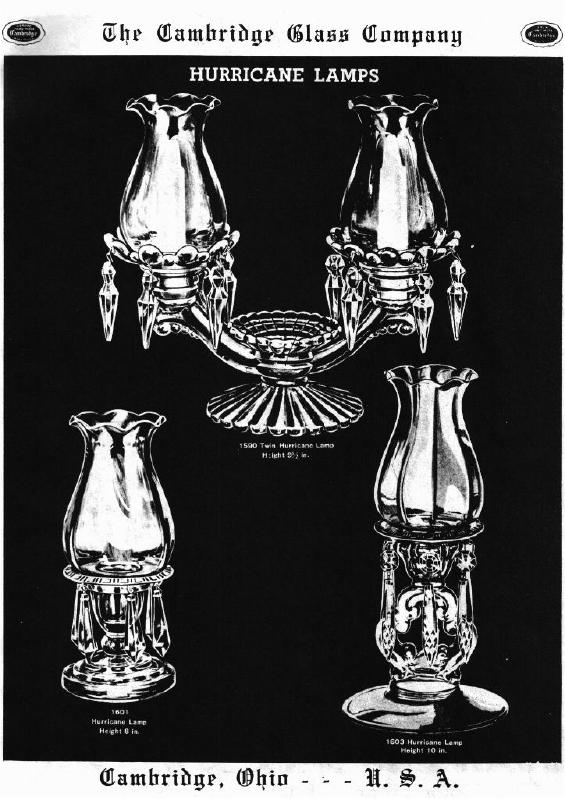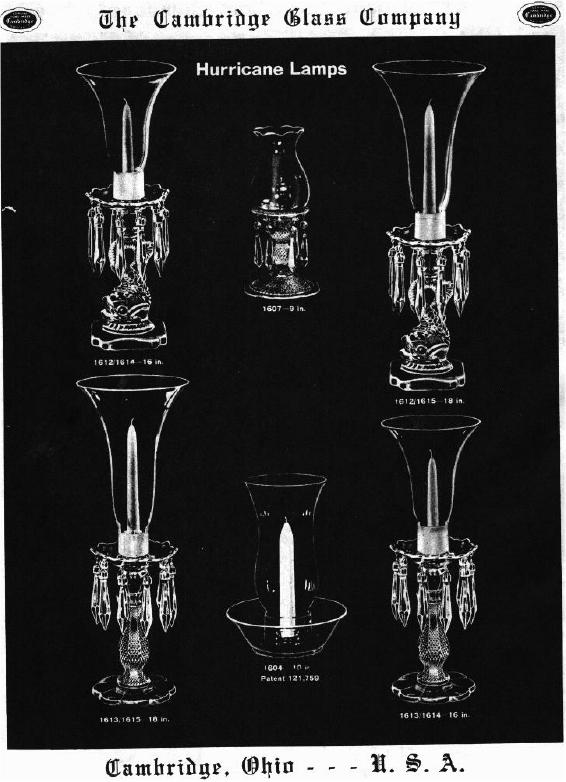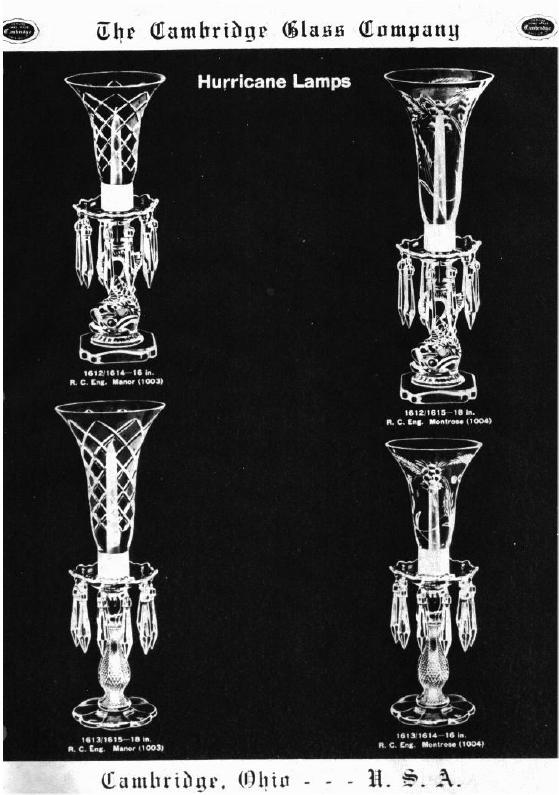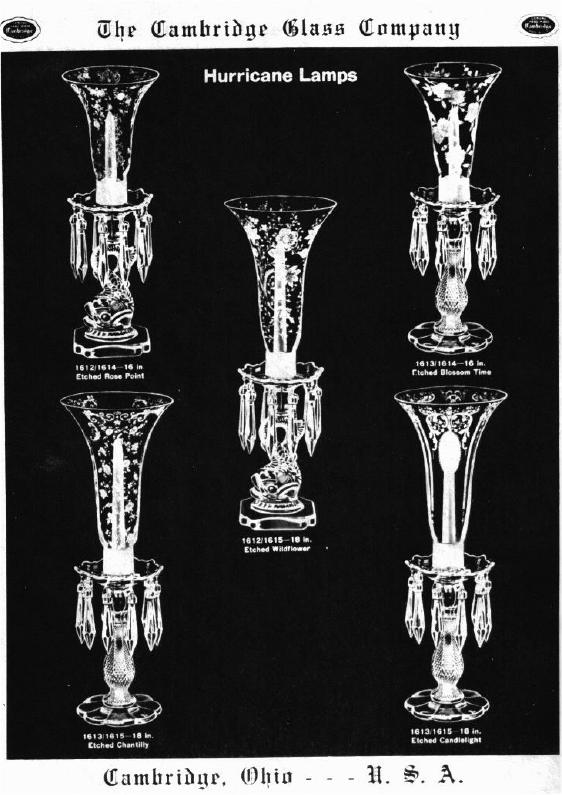Hurricane Lamps
by Mark A. Nye
Issue No. 224 - December 1991
Editor's Note: All Catalog pages referred to in this article can be found at the end of the article.
This type of candleholder derives its name from the presence of the glass shade (aka chimney) designed to shield the candle flame from breeze and light wind; whether or not it would function in a hurricane is something I would rather not undergo the experience to find out. Cambridge hurricane lamps usually, but not always, consist of four components: shade, candleholder (which serves as the lamp base), bobeche, and prisms; and can be broken down into their components, that is, they are not a fixed unit. The bobeche and prisms are decorative in nature and could be omitted from any of the Cambridge hurricane lamps without altering the basic function of providing candlelight in the presence of a breeze or light wind.
The January 1940 edition was the first Cambridge catalog to feature hurricane lamps. It is, however, no doubt safe to assume this type of candleholder entered the Cambridge line prior to that date, probably sometime during the second half of the 1930s. The initial 1940 catalog devoted a single page to showing three hurricane lamps and its price list makes mention of a fourth with a note "not illustrated." As happened with previous catalogs, supplemental pages began to be issued and three pages (one as early as June 1940) were dedicated to illustrating this item. A fourth supplemental page showed an additional hurricane lamp along with three other items.
The June 1949 Cambridge catalog pictured three hurricane lamps on one page and, sometime later, three additional hurricane lamps, all part of the Cambridge Arms line, became available. From the catalog issued following the reorganization and reopening in 1955, one could have ordered any one of four hurricane lamps or five shades. There was no longer a page or section devoted to hurricane lamps; those being offered appeared on several different pages. Hurricane lamps and shades were discontinued sometime between October 1956 and the issuance of the 1958 price list, thus ending a twenty year stint in the Cambridge line.
In addition to being offered undecorated, hurricane lamps, like candleholders, candelabra and epergnes, were available with the popular Cambridge etchings and a few rock crystal engravings. It is doubtful hurricane lamps in color, shades or bases, were ever offered.
Note that in all cases, while the candlestick remains unaltered in appearance, if it was to be used as a hurricane lamp base, a collar to hold the shade or chimney was added to the top of the candle socket.
The #1590 hurricane lamp consists of the #1588 candlestick, two #23 bobeches, 10 #5 prisms and two chimneys (no number provided). The #1601 utilizes the Pristine #506 candlestick, #27 bobeche, six #4 prisms and the same chimney as #1590. The very familiar candlestick #648 is the base for the #1603 hurricane lamp and completing it is a #27 bobeche, six #1 2 1/2" prisms and chimney.
The #1601 and #1603 were available, from the 1940 catalog, etched Blossom Time, Chantilly, Diane, Portia, Elaine, Rose Point and Wildflower. As listed in the January 1940 price list, #1601 came with an etched chimney or shade and plain base, while the #1603 had a plain chimney and etched shade. The #1590 is known with Rose Point etched shades and a plain base.
The fourth and originally not illustrated lamp is the #1607 consisting of the Mt. Vernon #131 candlestick, #27 bobeche, six #4 prisms and chimney. This item was later illustrated on a supplemental catalog page and will be seen on one of the catalog pages illustrating this article.
The first of the supplemental pages, to be issued showing hurricane lamps, was page 263 and probably was distributed in late spring 1940. The #1607 was finally illustrated as were five other hurricane lamps.
The #1604 was covered by a design patent applied for in February 1940, and issued the following August. Quoting from the patent:
"The essential feature of the design resides in the lamp base comprising a bowl having a candle socket provided in its bottom at the center of the bowl, the candle socket being encircled by a concentric circular partition wall located at a spaced distance from the candle socket."
In addition to being available plain, the #1604 was available engraved #1008; #988; and #1003 (Manor).
The #1612/1614 and #1612/1615 both make use of a variant of the #50 Dolphin candlestick, known, in this instance, as #1612; the variation being the addition of the collar to hold the chimney. Likewise, #1613/1615 and #1613/1614 have as their base candlestick the #1613, a variant of the 8" Mt. Vernon #35 candlestick. The last four digits of each item number designate the shade and all four incorporate a #29 bobeche and 10 #10 prisms.
The #1614 and #1615 shades have been documented etched Rose Point. The four lamps using these shades will have plain or not etched bases. These same two shades engraved Manor and Montrose combined with bases #1612 and #1613, bobeche and prisms into hurricane lamps were also being offered during spring and summer 1940 and probably for sometime after that.
At some point in time, hurricane lamps #1612/1614, #1612/1615, #1613/1614, and #1613/1615 also became available with shades etched Blossom Time, Wildflower, Chantilly and Candlelight and were illustrated on a catalog page issued sometime during the early 1940s. Were they also etched Elaine, Portia and Diane? Probably, although at this time I have no documentation in my possession to prove this. Collectors having examples are asked to write.
The final hurricane lamp shown in the 1940 catalog and its supplemental pages is the #1617 consisting of the Martha line #494 4" candlestick (with added collar) and a chimney. Since as designed, this basic candlestick has an attached bobeche, none was added for the hurricane lamp.
By June of 1949, all of the hurricane lamps discussed here, with the exception of the #1603 and #1617, had been discontinued.




